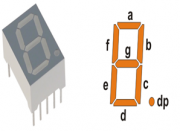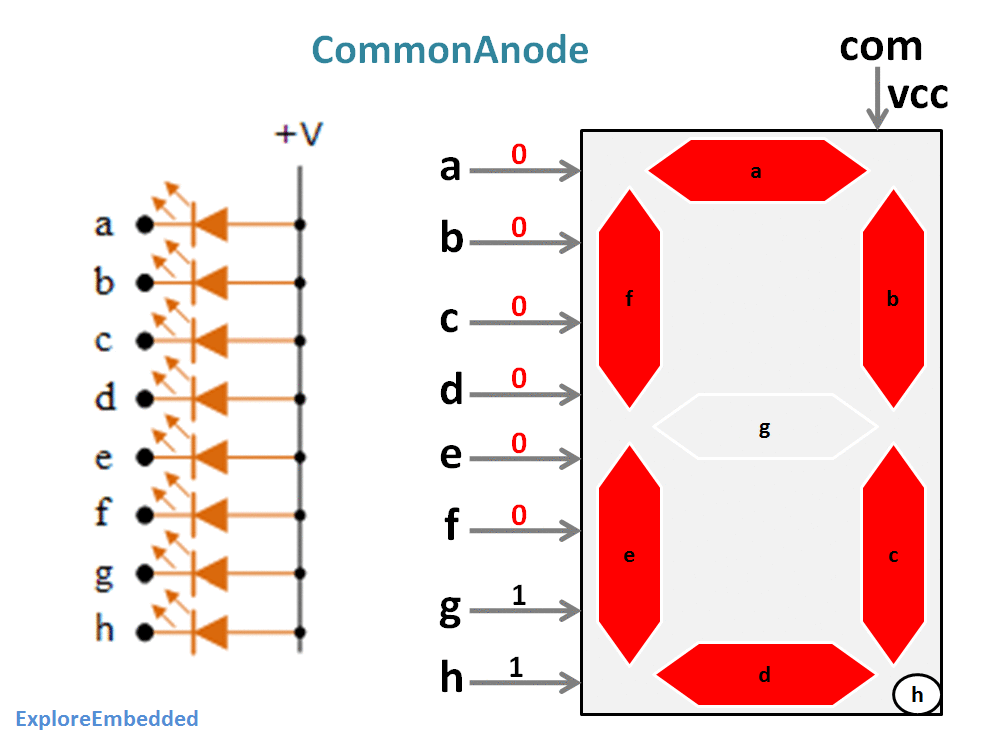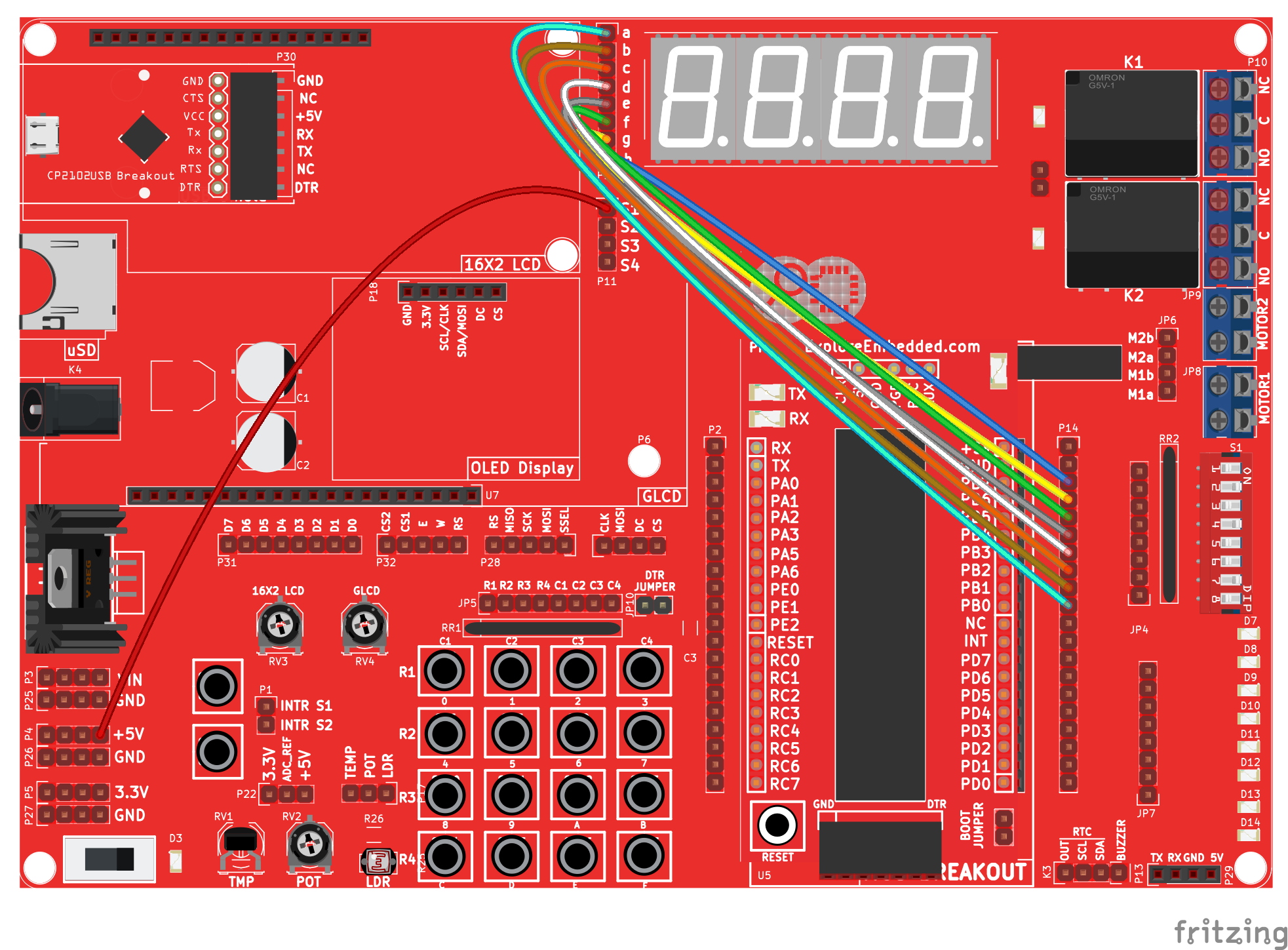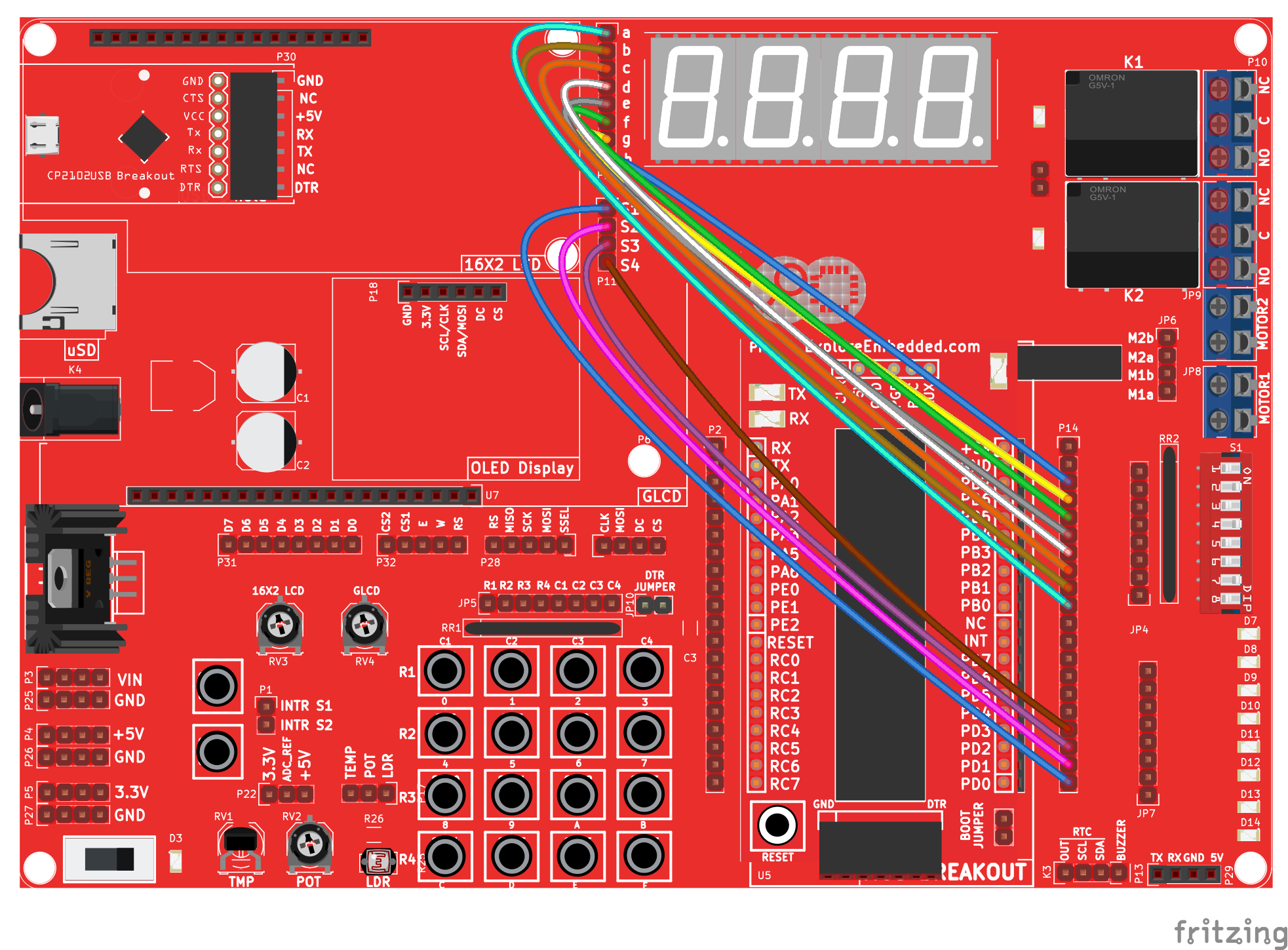Difference between revisions of "Interfacing Seven Segments with PIC16f877a"
| (13 intermediate revisions by 2 users not shown) | |||
| Line 1: | Line 1: | ||
[[Category:PIC Tutorials]] | [[Category:PIC Tutorials]] | ||
| − | In the earlier tutorials we saw how to interface the | + | In the earlier tutorials, we saw how to interface the LEDs to PIC microcontroller and wrote the code to blink them. However, the LEDs cannot be used to display any user information like numbers, chars etc. To display numeric values we can use seven segment displays.<br> |
| − | + | In this tutorial, we will interface a seven segment to PIC16f877a and display a single digit decimal counter(0-9). | |
| − | In this tutorial we will interface a seven segment to | + | |
Later same will be extended to multiplex 4 seven segment displays to generate a 4-digit counter. | Later same will be extended to multiplex 4 seven segment displays to generate a 4-digit counter. | ||
| − | <br><br> | + | <br><br><br> |
=Seven Segment Display= | =Seven Segment Display= | ||
[[File:BasicSevenSegmentDisplay.png|thumbnail|Basic 7 segment Display]] | [[File:BasicSevenSegmentDisplay.png|thumbnail|Basic 7 segment Display]] | ||
| − | Well, the name 7 segments | + | Well, the name 7 segments imply there are 7 LED segments arranged as shown in figure 1. |
After LEDs, these are the easiest interfaces to a microcontroller. | After LEDs, these are the easiest interfaces to a microcontroller. | ||
There is also a decimal point or dp. It is used when decimal digits like 5.1 etc are displayed. | There is also a decimal point or dp. It is used when decimal digits like 5.1 etc are displayed. | ||
==Applications== | ==Applications== | ||
| − | Seven | + | Seven segments are widely used in applications where digits[0-9] are required to be displayed.Although they also display letters A to F as shown in figure(2) simulation. |
This is a very simple and convenient way to display numbers in a bright fashion. | This is a very simple and convenient way to display numbers in a bright fashion. | ||
==Form Factor== | ==Form Factor== | ||
| Line 22: | Line 21: | ||
=Working= | =Working= | ||
| − | Since these are basically LEDs arranged as a group they can either have anode in common or cathode thus they are named as Common-Anode/Common-Cathode displays. | + | Since these are basically LEDs arranged as a group they can either have the anode in common or cathode thus they are named as Common-Anode/Common-Cathode displays. |
[[File:Common Cathode 7Segment.jpeg|thumbnail]] | [[File:Common Cathode 7Segment.jpeg|thumbnail]] | ||
[[File:Common Anode 7Segment.jpeg|thumbnail]] | [[File:Common Anode 7Segment.jpeg|thumbnail]] | ||
| Line 59: | Line 58: | ||
<br><br> | <br><br> | ||
| − | = | + | =Hardware Connection= |
| + | Below image shows the hardware connection as per the table.<br> | ||
| + | {| class="table table-striped table-hover table-condensed table-bordered" | ||
| + | |-class="info" | ||
| + | !a || b || c || d || e || f || g || h || COM | ||
| + | |- | ||
| + | |PD0 || PD1 || PD2 || PD3 || PD4 || PD5 || PD6 || PD7 || VCC | ||
| + | |} | ||
| − | =Code= | + | <br><br> |
| + | |||
| + | [[File:7SegmentSignleDigit bb.png|none]] | ||
| + | |||
| + | =Code: Single Segment= | ||
| + | Below is the sample code to display single digit up counter. | ||
<html> | <html> | ||
| − | <script src="https://gist.github.com/ | + | <script src="https://gist.github.com/SaheblalBagwan/436101343ba0a1a0e8eb6f6c9140e538.js"></script> |
| − | </script> | + | |
</html> | </html> | ||
| − | = | + | <br><br> |
| − | + | ||
| − | < | + | =Hardware Connections= |
| − | + | [[File:7Segment4Digit bb.png|none]] | |
| + | =Code: Four Segments= | ||
| + | Below is the sample code for multiplexing four segments to display 4-digit up counter. | ||
| + | <html> | ||
| + | <script src="https://gist.github.com/SaheblalBagwan/d6952b2b0efa63becd32ea71eb06acd3.js"></script> | ||
| + | </html> | ||
| + | =Downloads= | ||
| + | Download the complete project folder from the below link:<br> | ||
| + | [https://github.com/ExploreEmbedded/Pic16f877a_ExploreUltraPicDevKit/archive/master.zip Hardware design Files and Code Library] | ||
| − | |||
| − | |||
| − | |||
| − | Have | + | Have an opinion, suggestion , question or feedback about the article let it out here! |
{{DISQUS}} | {{DISQUS}} | ||
Latest revision as of 13:21, 27 August 2016
In the earlier tutorials, we saw how to interface the LEDs to PIC microcontroller and wrote the code to blink them. However, the LEDs cannot be used to display any user information like numbers, chars etc. To display numeric values we can use seven segment displays.
In this tutorial, we will interface a seven segment to PIC16f877a and display a single digit decimal counter(0-9).
Later same will be extended to multiplex 4 seven segment displays to generate a 4-digit counter.
Contents
Seven Segment Display
Well, the name 7 segments imply there are 7 LED segments arranged as shown in figure 1. After LEDs, these are the easiest interfaces to a microcontroller. There is also a decimal point or dp. It is used when decimal digits like 5.1 etc are displayed.
Applications
Seven segments are widely used in applications where digits[0-9] are required to be displayed.Although they also display letters A to F as shown in figure(2) simulation. This is a very simple and convenient way to display numbers in a bright fashion.
Form Factor
- Sizes:They come in various sizes; 0.28”, 0.3”, 0.32”, 0.36”, 0.39”, 0.4”, 0.5”, 0.56”, 0.6”, 0.8”, 1.0”, 1.2”, 1.5”, 1.8”, 2.0”, 2.3”, 3.0”, 4.0”, 5.0”, 7.0”)
- Colors: and varied colors too; Red, Green, Yellow, Orange, Blue, and White.
Working
Since these are basically LEDs arranged as a group they can either have the anode in common or cathode thus they are named as Common-Anode/Common-Cathode displays.
- Common Cathode: In this type of segments all the cathode terminals are made common and tied to GND. Thus the segments a to g needs a logic High signal(5v) in order to glow.
- Common Anode: In this type of segments all the anodes terminals are made common and tied to VCC(5v). Thus the segments a to g needs a logic LOW signal(GND) in order to glow.
Below table shows the binary/hex values for displaying the digits on CommonAnode seven segment display.
| Digit | h | g | f | e | d | c | b | a | Hex Value |
| 0 | 1 | 1 | 0 | 0 | 0 | 0 | 0 | 0 | 0xC0 |
| 1 | 1 | 1 | 1 | 1 | 1 | 0 | 0 | 1 | 0xF9 |
| 2 | 1 | 0 | 1 | 0 | 0 | 1 | 0 | 0 | 0xA4 |
| 3 | 1 | 0 | 1 | 1 | 0 | 0 | 0 | 0 | 0xB0 |
| 4 | 1 | 0 | 0 | 1 | 1 | 0 | 0 | 1 | 0x99 |
| 5 | 1 | 0 | 0 | 1 | 0 | 0 | 1 | 0 | 0x92 |
| 6 | 1 | 0 | 0 | 0 | 0 | 0 | 1 | 0 | 0x82 |
| 7 | 1 | 1 | 1 | 1 | 1 | 0 | 0 | 0 | 0xF8 |
| 8 | 1 | 0 | 0 | 0 | 0 | 0 | 0 | 0 | 0x80 |
| 9 | 1 | 0 | 0 | 1 | 0 | 0 | 0 | 0 | 0x90 |
Hardware Connection
Below image shows the hardware connection as per the table.
| a | b | c | d | e | f | g | h | COM |
|---|---|---|---|---|---|---|---|---|
| PD0 | PD1 | PD2 | PD3 | PD4 | PD5 | PD6 | PD7 | VCC |
Code: Single Segment
Below is the sample code to display single digit up counter.
Hardware Connections
Code: Four Segments
Below is the sample code for multiplexing four segments to display 4-digit up counter.
Downloads
Download the complete project folder from the below link:
Hardware design Files and Code Library
Have an opinion, suggestion , question or feedback about the article let it out here!






